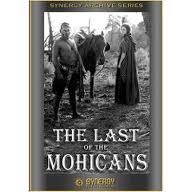The earliest known film versions of James Fenimore Cooper's popular imaging of the so-called "French and Indian War" were both filmed in 1911. The first of which had a release date of 5 August 1911 and was produced by
Powers Picture Company. The other version had a release date of
10 November 1911, produced by the Thanhouser Film Company, the movie was actually shot on location in Lake George NY and starred James Cruz, a Ute, in the role of Uncas. I am not at all sure of the survival of either of these two landmark films. I'll have to do some digging.
I'm a huge silent film buff, and have noticed that many films about American Indian subject in the 19 teens actually did make a seriously effort to cast actual Native Americans in Indian roles. This, of course, dried up in the 1930's and only got worse, until the Western as a mainstream film genre more or less went out of fashion, not surprisingly, when the civil rights movements gained momentum.
The first commercially successful film release of the story came in 1920, when hulking actor Wallace Beery took on the role of
Magua. This film IS still very much in existence and was up until recently in print on DVD.
Michael Mann's 1992 release is regarded far and away as the best commitment of the novel to film bar-none. In addition to Studi, it starred Native American activist Russell Means (Oglala Lakota Sioux) as Chingachgook and Eric Schweig (Inukitut (Eskimo)/Cree) as Uncas and, of course, Daniel Day Lewis as the wiley adopted Mohican son Hawkeye. It does not get mentioned that the role of the Huron chief Onagewasgone was played by Means' fellow activist Dennis Banks (Anishinabe [Ojibwe]), and, of course, a whole host of actual natives from various Nations, Tribes and Bands in the part of various, and numerous, extras.
 |
| Russell Means |
 |
| Eric Schweig |
 |
| Daniel Day Lewis |
 |
| Mike Phillips corrected by "vigo krell" 2012 |
 |
| Some Of The Extras With Lewis |
As for the Mohican people themselves, they are, surprisingly to most people, not gone. They are still here. The transplanted
Stockbridge Munsee Band of Mohicans have a thriving community in northern Wisconsin. They have several businesses that they own and invest in that are helping them to become a much more independent community (and, yes, one of them is a casino). Prominent musicians who are Mohican are Janice Marie Johnson of the legendary funk & disco group A Taste Of Honey was inducted into the Native American Music Hall of Fame in 2008. And singer/songwriter Bill Miller, who has received several Nammys over the years, including a Lifetime Achievement Award.
 |
| Janice Marie Johnson |
 |
| Bill Miller |
Regarding the Languages Used In The Film:
The Wyandot (Huron) language is extinct. It was an Iroquoian language like Mohawk, Seneca, Cherokee, ect. Language revival programs are underway both here in the US and in Canada. Despite that the IMDb say that they movie is in English, French and Mohawk. The language that Studi is sometimes speaking is actually Cherokee. Studi even provided a Cherokee translation for the Clannad song "I Will Find You" for the soundtrack. As for Mohican, it has been extinct longer than Wyandot, but there is a comprehensive dictionary, so perhaps that was used for some of the Mohican lines. I do not know of any revival programs currently in the works for it.










There is much that is incorrect in this post.
ReplyDeleteFirst of all, Sachem was played by Mike Phillips (Kanentakeron), not Dennis Banks.
Secondly, while it is true the Wyandot language died out some centuries ago, there are revitalization programs happening in Oklahoma and elsewhere.
Thirdly, the Mohawk (or Kanien’kéha) language is most certainly not dead. It has around 3,500 native speakers remaining, and is taught in many Kanienkehaka areas.
It is true that Wes Studi spoke some Cherokee in the film, because as you say, there were no Wyandot speakers to translate some of the lines. But Mike Phillips, who is actually a Mohawk Chief, speaks Mohawk for all his scenes.
If you look closely you will see that I DID NOT say that the Mohawk language is dead! I know full well that it is not. Or you confusing the Mohican people with Mohawk?? If so, there is nothing I can do to help you there! The Mohican (more precisely Mahican) language was a member of the Algonquin language group, not an Iroquoian one like Mohawk...and Wyandot....and "Cherokee"....and Oneida, Onondaga, Cayuga and Seneca, just to name the ones that ARE STILL SPOKEN. I am aware that there a number of revival programs--AS I SAID!! The "Sachem" that I am attempting to refer to is the character Ongewasgone--I could have made that more clear. Still I am shocked that you actually thought I was saying that Mohawk was dead--I didn't! Mahican is, unfortunately. I also mentioned that Mohawk is spoken in the film, Also, this is a live blog, so it's written as films are watched. It is not intended to be a scholarly blog spot, it supposed to be fun.
DeleteWhere are you from?? Just wondering 3 years on. Really "Vigo Krell" is lecturing me about in an Native American language? 'who the hell are you?????
ReplyDelete